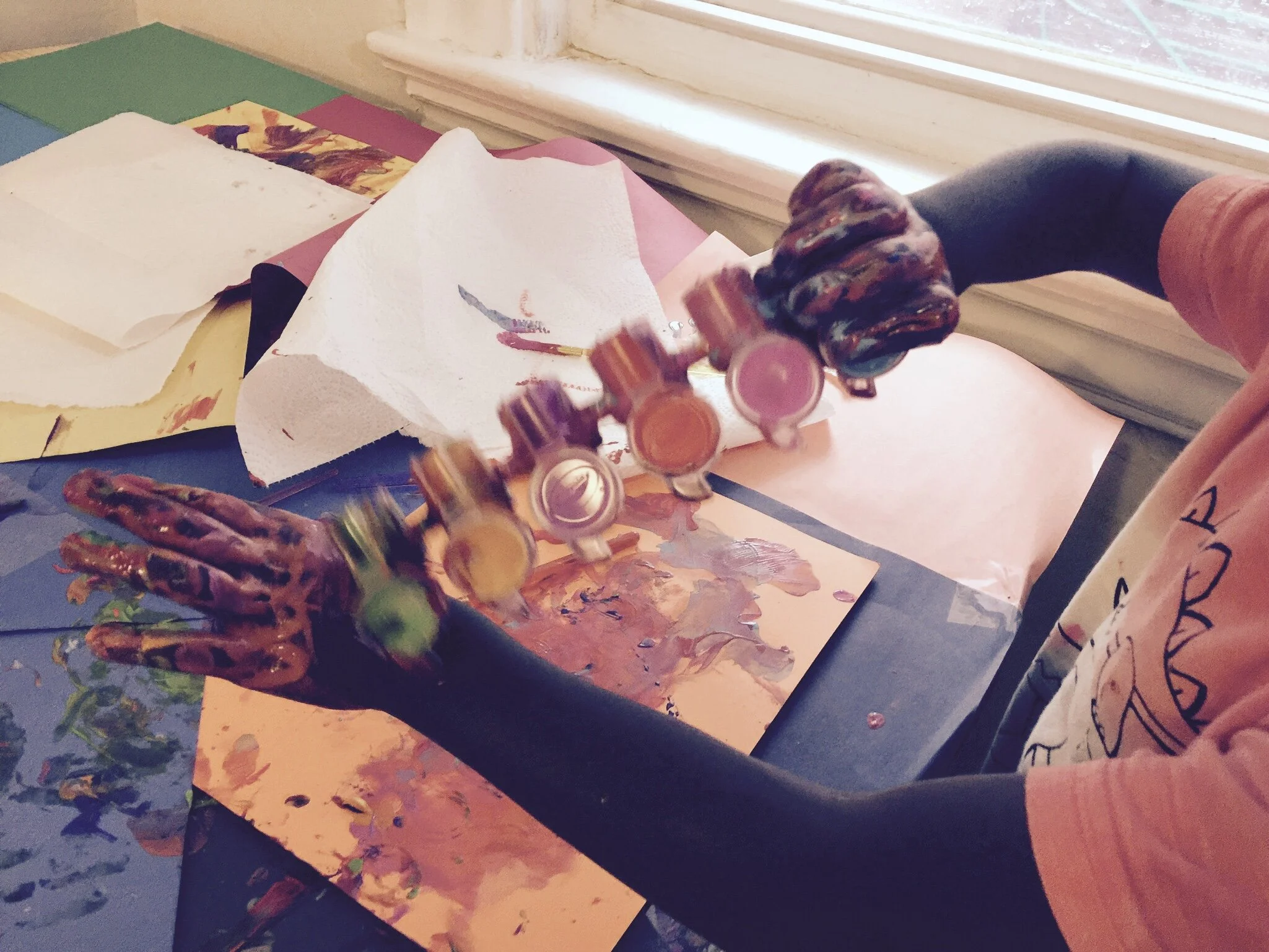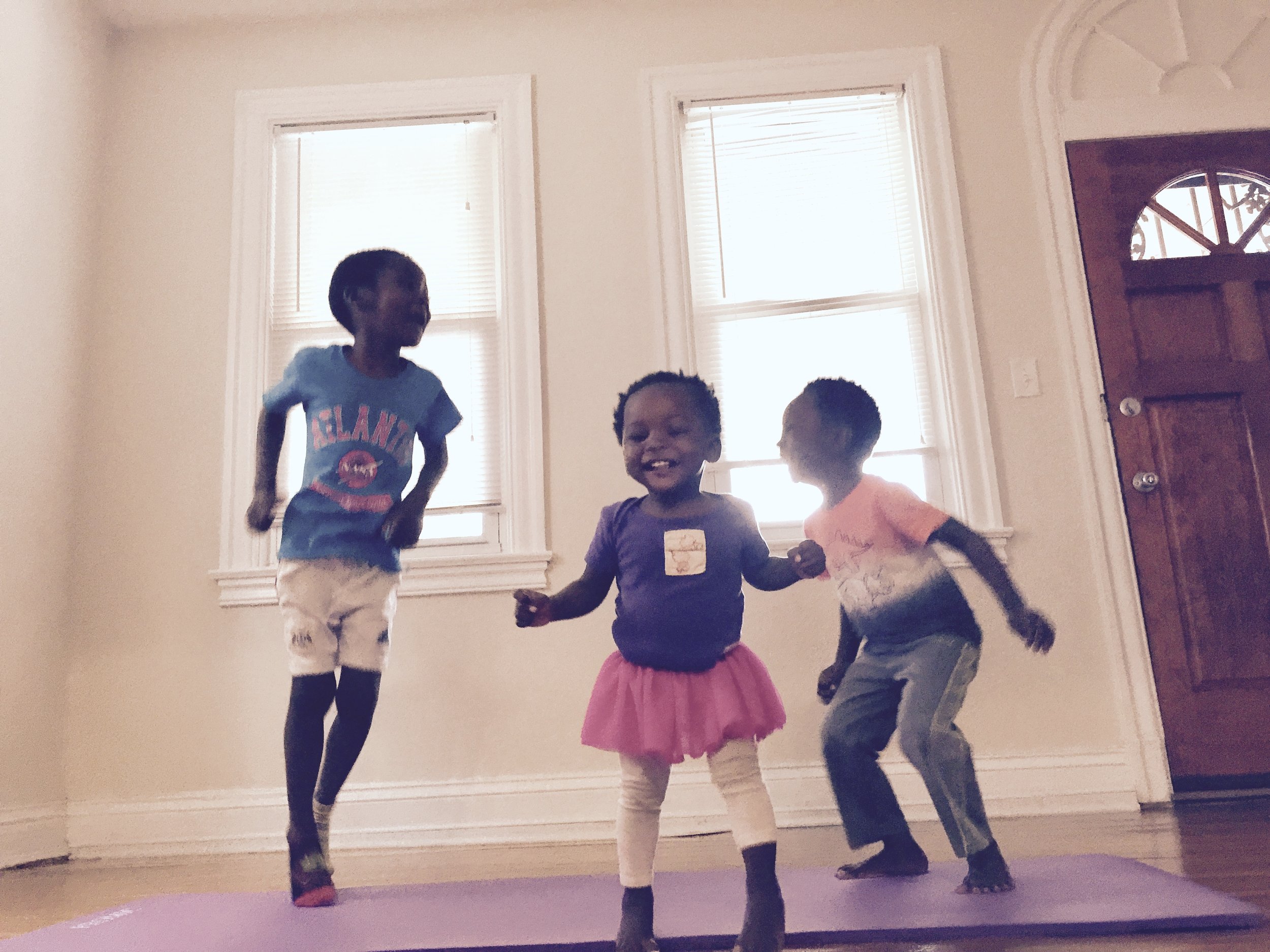The big munchkins paint while the baby naps.
It seems overnight that our world has kind of turned upside down, and is actually still rapidly changing everyday. We’re all adjusting and adapting as best we can, our children too. This is a lot on all of us. We all respond to abrupt change differently. Many people seek out familiarity and assurance in times of uncertainty—things like structure, routine, and schedules— and are asking themselves “How can I create more structure in our day?”
I will also start by saying that maintaining structure when it comes to our family learning lab has never been a priority—or a strong skillset—of mine. I do come across this question often and—contrary to what some people in my family will tell you—I am not entirely opposed to structure. It serves us at times, I get that. And especially now with so many parents navigating the unexpected reality of facilitating their children’s learning at home for the foreseeable future, this question around structure is on a lot of people’s minds.
Honestly, I have no simple answer to this. But I do think this conversation is an awesome opportunity for advancing discovery and building community as parents and caregivers who are ourselves facing a brand new world right now. So in the interest of learning and growing, I have thought up these 3 writing/dialogue/thinking activities to do when considering whether or not having (more) structure matters right now. Then I’m going to share some of the ways I apply these tools on days when the ideal structure isn’t attainable and I have to use my creativity to find a better way.
My hope is that these short activities will help you get super-present with what your family truly needs. Collaborative, family-centered learning is all about keeping everyone—parents, children, aunties, grandmothers (whoever lives at home with you and in your day-to-day reality)—in mind when exploring what is best. It takes time to learn what everyone in our family needs and to find our optimal flow. Be gentle with yourself and everyone else through the discovery process.
1. Assessing Relevance
First question—and it might seem like a silly question, but trust me, it’s not—Why do you need structure? Make a list of all the reasons you feel you need structure. After completing your list, do a truth-check by asking yourself: “Is it absolutely true, with all that’s going on in my life today, that I need to have/be responsible for ______ (insert item from your list) right now?” Be sure to ask yourself this for each thing you put on the list.
If the answer is YES, keep it on the list. If the answer is NO, scratch it off the list. After you have done a truth-check for everything on your list, rewrite the list on a new page with only the things you said YES to. Set your list aside, we’re going to revisit it later.
Knowing YOUR family’s answer to why structure is or isn’t needed will greatly impact how you go about creating and facilitating your family’s learning practice. In thinking about this, we need to be very honest with ourselves and with all we’re managing everyday. There is no right or wrong way to answer these questions. Everyone has different factors on their plates and values things according to their beliefs, culture, and circumstances. Beginning with clarity here will lead to making choices and finding solutions that really work and sustain us.
2. Assessing Meaning
Next area of exploration: What does it mean to learn? Answer this in your own words, without googling a definition. Just off the top of your head, what does learning mean to you? Write your meaning of learning down in a journal. Now beside it or underneath it, answer this too: What does it mean to have structure? Again in your own words and without editing or censoring.
Once you feel good about your answers, take some time to really reflect on what came up for you. Observe the natural moments of your family rhythms. Where do learning and structure already overlap? Where do they diverge? How can they coexist more peacefully? How, if at all, do they require different things? Give yourself permission to be transparent with your answers. Honesty leads to greater clarity and understanding, which in turn leads to more peace, joy, and positivity for our family’s learning practice.
3. Assessing Possibility
Now go and get your truth-checked list from the first activity. For everything that you are absolutely sure you need (when it comes to structure) in order to sustain your family’s wellness, you’re going to identify Places of Possibility—P.O.P.s—that align with your family’s learning practice.
Start with the most important thing on your YES list. Write it down on its own sheet of paper and draw a circle around it. This is your P.O.P. circle. Then consider the following questions:
How can my children collaborate with me to meet this need?
How does this need already relate to something my children are interested in/excited about learning?
How can I meet this need while being present with my children?
For now, just brainstorm your answers. You can write them down as a list, or draw a line extending outward from your circle for every answer you put down, so that each P.O.P. circle will look like a sun when you’ve accumulated all your answers.
Just one of the reasons I am usually too scared to let my children paint when I am the only adult in the house.
Practicing A New Way Forward
One thing that determines whether or not my crew is going to have a good day is how much food—read: what kinds of snacks do I have on hand to incentive cooperation at any given moment!—we have in the house. This is determined primarily by how much money is in the bank and how/when we can get to the store.
I know that if we start our day without the optimal selections of food, that I am going to soften all plans. Hangry children are not feeling story time! I’m going to be gentle with myself as the mother who has to spend a whole day on my own with munchkins who are underwhelmed about having beans and rice, again. I’m going to honor the limitations of the moment and proactively look for other ways to create peace in our day, like more babywearing, more touch, more snuggling, more freedom to play and make noise, more tablet time. By softening the structure of what I wanted our day to be, I am able to be more responsive to the truth of the moment, which is that I don’t have enough food in the house to facilitate a smooth day.
When assessing whether or not a particular structure is really possible at any given moment, always check in to see if you’ve been honest about what is really going on for you and your family. Once I can accept the truth, I can more readily access the P.O.P.s that will get me through this moment. My kids love going for a walk. So maybe instead of feeling bad that we didn’t get our morning reading done, we’ll burn some energy by walking to the store to pick up a few things. My kids love baking, so if there’s no money to go to the store, I might center our day around making cookies with them instead of feeling frustrated that the laundry is still a mountain in front of the closet. My children love dancing, so instead of demanding my kids sit still at the table and eat this very nutritious, you-have-to-eat-this-because-I-don’t-have-anything-else-in-the-house-and-I-can’t-deal-with-you-crying-all-day-because-you’re-hungry meal, I might blast some of their favorite jams and dish out spoonfuls of food while they dance and run around until all bowls are empty and all bellies are full.
It’s not always easy to see and access the P.O.P. And even though I know my grandmother would disapprove, the truth is that it’s much easier to feed children who don’t want to eat what you have when you give them alternative ways to express their freedom. Also, the more opportunities for collaboration we embrace when navigating our family’s essential needs, the more learning moments and meaningful exchanges occur organically throughout the day.
And again, everything going on in our world right now is a lot to process. One day, one breath, at a time. It’s okay if you find it challenging—or even impossible—to find places of possibility with some of your family’s critical needs. For instance, if there is something you have to do that you cannot do with your children, give yourself permission to do that when they are sleeping, or when they are in someone else’s care, or when they’re having a screen time break, or any other creative pocket of time you can access.
Surviving and thriving in times of uncertainty means that we might have to break a lot to the rules that were necessary to maintaining a structure that is no longer relevant or harmonious for our family’s well-being.
This can feel very uncomfortable or intimidating, and like extremely new, unchartered terrain—because it is!— but this in itself is also a powerful place of possibility and learning for us and our children. Something amazing, and beautiful, and magical might now emerge with the abandoning of structure and the embracing of more honesty, understanding, communication, and creativity.
Remember that nurturing a collaborative, family-centered learning process takes time, patience, experimentation, and practice. Begin where you can begin. Start with where you are today and with what you have in front of you right now. You might soon realize that your new flow is more possible, and feels better, than anything you had before.











